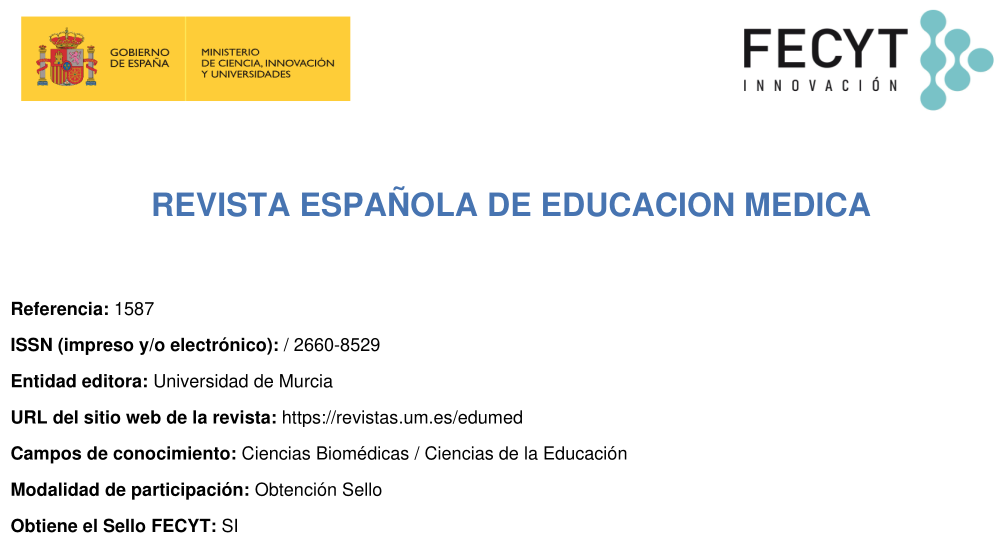Spatial Orientation References in 3D Anatomy Apps
Abstract
In this research work the perception of 3D anatomy applications was evaluated in relation to a teaching strategy based on cognitive foundations of digital image manipulation. Two groups of students entering the medical career received training in the use of 3D anatomy software applications, only one of the groups received additional information on memory limitations in the retention of three-dimensional images and strategies for appropriate use of rotation controls that avoid cognitive overload. Perception was evaluated with a technology acceptance model (TAM) and a significant difference was found between both groups in favor of the trained group. We interpret We infer that the incorporation of 3D anatomy applications in traditional 2D screen devices will have greater acceptance (that is, probability of future use) when it is accompanied by a self-regulation strategy to avoid the disorientation effects produced by the characteristic uncontrolled rotations in self-taught use.
Downloads
Metrics
-
Abstract986
-
pdf (Español (España))823
References
Prensky M. Digital Natives, Digital Immigrants Part 1. Horiz. septiembre de 2001;9(5):1-6. https://www.marcprensky.com/writing/Prensky%20-%20Digital%20Natives,%20Digital%20Immigrants%20-%20Part1.pdf
Duarte A. Aproximación al estudio de la cognición. Publicación del Centro de Estudiantes de Psicología Universidad de Buenos Aires. 1986.
Burin D. Aníbal Duarte. Subj. procesos cogn. 2010; 14(1). Disponible en: http://www.scielo.org.ar/scielo.php?script=sci_arttext&pid=S1852-73102010000100002.
Preim B, Saalfeld P. A survey of virtual human anatomy education systems. Comput Graph. 1 de abril de 2018;71:132-53. https://doi.org/10.1016/j.cag.2018.01.005.
Bergman EM, Prince KJ, Drukker J, van der Vleuten CP, Scherpbier AJ. How much anatomy is enough? Anat Sci Educ. 2008 Jul-Aug;1(4):184-8. http://doi.org/10.1002/ase.35
McKeown PP, Heylings DJ, Stevenson M, McKelvey KJ, Nixon JR, McCluskey DR. The impact of curricular change on medical students' knowledge of anatomy. Med Educ. 2003 Nov;37(11):954-61. http://doi.org/10.1046/j.1365-2923.2003.01670.x
Spielmann PM, Oliver CW. The carpal bones: a basic test of medical students' and junior doctors' knowledge of anatomy. Surgeon. 2005 Aug;3(4):257-9. http://doi.org/10.1016/s1479-666x(05)80087-3
Waterston SW, Stewart IJ. Survey of clinicians' attitudes to the anatomical teaching and knowledge of medical students. Clin Anat. 2005 Jul;18(5):380-4. http://doi.org/10.1002/ca.20101
Garg A, Norman GR, Spero L, Maheshwari P. Do virtual computer models hinder anatomy learning? Acad Med. 1999 Oct;74(10 Suppl):S87-9. http://doi.org/10.1097/00001888-199910000-00049
Garg AX, Norman GR, Eva KW, Spero L, Sharan S. Is there any real virtue of virtual reality?: the minor role of multiple orientations in learning anatomy from computers. Acad Med. 2002 Oct;77(10 Suppl):S97-9. http://doi.org/10.1097/00001888-200210001-00030
Huk T. Who benefits from learning with 3D models? the case of spatial ability. J Comput Assist Learn. 2006;22(6):392-404. https://doi.org/10.1111/j.1365-2729.2006.00180.x
Khot Z, Quinlan K, Norman GR, Wainman B. The relative effectiveness of computer-based and traditional resources for education in anatomy. Anat Sci Educ. 2013 Jul-Aug;6(4):211-5. http://doi.org/10.1002/ase.1355
Levinson AJ, Weaver B, Garside S, McGinn H, Norman GR. Virtual reality and brain anatomy: a randomised trial of e-learning instructional designs. Med Educ. 2007 May;41(5):495-501. http://doi.org/10.1111/j.1365-2929.2006.02694.x
Berney S, Bétrancourt M. Learning Three-Dimensional Anatomical Structures with Animation: Effect of Orientation References and Learners’ Spatial Ability. En: Learning from Dynamic Visualization: Innovations in Research and Application. 2017.
Mayer R. Guiding Cognitive Processing During Learning with Animations: Commentary on Parts III and IV. En: Learning from Dynamic Visualization: Innovations in Research and Application. 2017.
Stull A, Hegarty M, Mayer R. Anatomy Learning with Virtual Objects. En: AAAI Spring Symposium - Technical Report. 2010.
Stull AT, Hegarty M, Mayer RE. Getting a handle on learning anatomy with interactive three-dimensional graphics. J Educ Psychol. 2009;101(4):803-16.https://doi.org/10.1037/a0016849
Hegarty M. Chapter 7 - Components of Spatial Intelligence. En: Psychology of Learning and Motivation [Internet]. Academic Press; 2010 [citado 5 de marzo de 2021]. p. 265-97. (The Psychology of Learning and Motivation; vol. 52). Disponible en: https://www.sciencedirect.com/science/article/pii/S0079742110520073
Davis FD. Perceived Usefulness, Perceived Ease of Use, and User Acceptance of Information Technology. MIS Quarterly. 1989;13(3):319-40. https://doi.org/10.2307/249008
OECD (2015), Students, Computers and Learning: Making the Connection, PISA, OECD Publishing. https://www.oecd.org/publications/students-computers-and-learning-9789264239555-en.htm
Hu, C. Students, computers and learning: Where is the connection? Educ Inf Technol 22, 2665–2670 (2017). https://www.oecd.org/publications/students-computers-and-learning-9789264239555-en.htm
Schmid, Regina; Petko, Dominik (2019). Does the use of educational technology in personalized learning environments correlate with self-reported digital skills and beliefs of secondary-school students? Computers and Education, 136:75-86. https://doi.org/10.1016/j.compedu.2019.03.006
Copyright (c) 2021 Servicio de Publicaciones de la Universidad de Murcia

This work is licensed under a Creative Commons Attribution-NonCommercial-NoDerivatives 4.0 International License.
The works published in this magazine are subject to the following terms:
1. The Publications Service of the University of Murcia (the publisher) preserves the economic rights (copyright) of the published works and favors and allows them to be reused under the use license indicated in point 2.
2. The works are published under a Creative Commons Attribution-NonCommercial-NoDerivative 4.0 license.
3. Self-archiving conditions. Authors are allowed and encouraged to disseminate electronically the pre-print versions (version before being evaluated and sent to the journal) and / or post-print (version evaluated and accepted for publication) of their works before publication , since it favors its circulation and earlier diffusion and with it a possible increase in its citation and reach among the academic community.


















